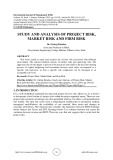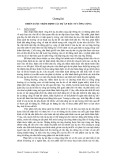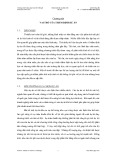
Chapter 12
The Design of the Tax System
TRUE/FALSE
1. The average American pays a higher percent of his income in taxes today than he would have in the late 18th
century.
ANS: T DIF: 1 REF: 12-0
NAT: Analytic LOC: The role of government TOP: Tax burden
MSC: Applicative
2. The U.S. tax burden is high compared to many European countries, but is low compared to many other nations
in the world.
ANS: F DIF: 1 REF: 12-1
NAT: Analytic LOC: The role of government TOP: Tax burden
MSC: Applicative
3. Poor countries such as India and Pakistan usually have low tax burdens.
ANS: T DIF: 1 REF: 12-1
NAT: Analytic LOC: The role of government TOP: Tax burden
MSC: Applicative
4. The U.S. federal government collects about one-half of the taxes in our economy.
ANS: F DIF: 1 REF: 12-1
NAT: Analytic LOC: The role of government TOP: Tax burden
MSC: Applicative
5. Individual income taxes and social insurance taxes generate the highest tax revenue for the federal
government.
ANS: T DIF: 2 REF: 12-1
NAT: Analytic LOC: The role of government TOP: Taxes
MSC: Applicative
6. Individual income taxes generate rougly 25% of the tax revenue for the federal government.
ANS: F DIF: 2 REF: 12-1
NAT: Analytic LOC: The role of government TOP: Taxes
MSC: Applicative
7. Income taxes and property taxes generate the highest tax revenue for state and local governments.
ANS: F DIF: 2 REF: 12-1
NAT: Analytic LOC: The role of government TOP: Taxes
MSC: Applicative
8. Sales taxes generate nearly 50% of the tax revenue for state and local governments.
ANS: F DIF: 2 REF: 12-1
NAT: Analytic LOC: The role of government TOP: Taxes
MSC: Applicative
9. Some states do not have a state income tax.
ANS: T DIF: 1 REF: 12-1
NAT: Analytic LOC: The role of government TOP: Income taxes
MSC: Applicative
10. By law, all states must have a state income tax.
ANS: F DIF: 1 REF: 12-1
NAT: Analytic LOC: The role of government TOP: Income taxes
MSC: Applicative
13

14 Chapter 12 /The Design of the Tax System
11. Social Security is an income support program, designed primarily to maintain the living standards of the poor.
ANS: F DIF: 2 REF: 12-1
NAT: Analytic LOC: The role of government TOP: Government spending
MSC: Applicative
12. A budget surplus occurs when government receipts fall short of government spending.
ANS: F DIF: 1 REF: 12-1
NAT: Analytic LOC: The study of economics, and definitions of economics
TOP: Budget surpluses MSC: Definitional
13. A budget surplus occurs when government receipts exceed government spending.
ANS: T DIF: 1 REF: 12-1
NAT: Analytic LOC: The study of economics, and definitions of economics
TOP: Budget surpluses MSC: Definitional
14. A budget deficit occurs when government receipts exceed government spending.
ANS: F DIF: 1 REF: 12-1
NAT: Analytic LOC: The study of economics, and definitions of economics
TOP: Budget deficits MSC: Definitional
15. A budget deficit occurs when government receipts fall short of government spending.
ANS: T DIF: 1 REF: 12-1
NAT: Analytic LOC: The study of economics, and definitions of economics
TOP: Budget deficits MSC: Definitional
16. As of 2005, the largest source of receipts for state and local governments was individual income taxes.
ANS: F DIF: 1 REF: 12-1
NAT: Analytic LOC: The role of government TOP: Taxes
MSC: Interpretive
17. As of 2005, the largest source of receipts for state and local governments was corporate income taxes.
ANS: F DIF: 1 REF: 12-1
NAT: Analytic LOC: The role of government TOP: Taxes
MSC: Interpretive
18. In the United States, all families pay the same proportion of their income in taxes.
ANS: F DIF: 1 REF: 12-1
NAT: Analytic LOC: The role of government TOP: Taxes | Income
MSC: Interpretive
19. One reason for the projected increase, over the next several decades, in government spending as a percentage
of GDP is the projected increase in the size of the elderly population.
ANS: T DIF: 1 REF: 12-1
NAT: Analytic LOC: The role of government TOP: Government spending
MSC: Interpretive
20. The administrative burden of any tax system is part of the inefficiency it creates.
ANS: T DIF: 1 REF: 12-2
NAT: Analytic LOC: Efficiency and equity TOP: Taxes
MSC: Interpretive
21. One characteristic of an efficient tax system is that it minimizes the costs associated with revenue collection.
ANS: T DIF: 2 REF: 12-2
NAT: Analytic LOC: Efficiency and equity TOP: Taxes
MSC: Interpretive

Chapter 12 /The Design of the Tax System 15
22. The administrative burden of complying with tax laws is a cost to the government but not to taxpayers.
ANS: F DIF: 2 REF: 12-2
NAT: Analytic LOC: Efficiency and equity TOP: Taxes
MSC: Interpretive
23. The equity of a tax system concerns whether the tax burden is distributed equally among the population.
ANS: F DIF: 2 REF: 12-2
NAT: Analytic LOC: Efficiency and equity TOP: Taxes
MSC: Interpretive
24. An efficient tax system is one that imposes small deadweight losses and small administrative burdens.
ANS: T DIF: 2 REF: 12-2
NAT: Analytic LOC: Efficiency and equity TOP: Taxes
MSC: Interpretive
25. Deadweight losses arise because a tax causes some individuals to change their behavior.
ANS: T DIF: 2 REF: 12-2
NAT: Analytic LOC: Efficiency and equity TOP: Deadweight losses
MSC: Interpretive
26. If a tax generates a reduction in surplus that is exactly offset by the tax revenue collected by the government,
the tax does not have a deadweight loss.
ANS: T DIF: 2 REF: 12-2
NAT: Analytic LOC: Efficiency and equity TOP: Deadweight losses
MSC: Analytical
27. Resources devoted to complying with the tax laws are a type of deadweight loss.
ANS: T DIF: 2 REF: 12-2
NAT: Analytic LOC: Efficiency and equity TOP: Deadweight losses
MSC: Applicative
28. An advantage of a consumption tax is that it does not distort the incentive to save.
ANS: T DIF: 2 REF: 12-2
NAT: Analytic LOC: Efficiency and equity TOP: Consumption taxes
MSC: Interpretive
29. Tax evasion is legal, but tax avoidance is illegal.
ANS: F DIF: 1 REF: 12-2
NAT: Analytic LOC: The study of economics, and definitions of economics
TOP: Income taxes MSC: Applicative
30. Tax evasion is illegal, but tax avoidance is legal.
ANS: T DIF: 1 REF: 12-2
NAT: Analytic LOC: The study of economics, and definitions of economics
TOP: Income taxes MSC: Applicative
31. In practice, the U.S. income tax system is filled with special provisions that alter a family's tax based on its
specific circumstances.
ANS: T DIF: 1 REF: 12-2
NAT: Analytic LOC: The role of government TOP: Income taxes
MSC: Applicative
32. If Christopher earns $80,000 in taxable income and pays $20,000 in taxes, his average tax rate is 20 percent.
ANS: F DIF: 2 REF: 12-2
NAT: Analytic LOC: The study of economics, and definitions of economics
TOP: Average tax rate MSC: Analytical

16 Chapter 12 /The Design of the Tax System
33. If James earns $80,000 in taxable income and pays $20,000 in taxes, his average tax rate is 25 percent.
ANS: T DIF: 2 REF: 12-2
NAT: Analytic LOC: The study of economics, and definitions of economics
TOP: Average tax rate MSC: Analytical
34. If Mary earns $80,000 in taxable income and pays $40,000 in taxes, her marginal tax rate must be 50 percent.
ANS: F DIF: 2 REF: 12-2
NAT: Analytic LOC: The study of economics, and definitions of economics
TOP: Marginal tax rate MSC: Analytical
35. Many people consider lump-sum taxes to be unfair to low-income taxpayers.
ANS: T DIF: 1 REF: 12-2
NAT: Analytic LOC: The role of government TOP: Lump-sum taxes
MSC: Interpretive
36. Lump-sum taxes are equitable but not efficient.
ANS: F DIF: 2 REF: 12-2
NAT: Analytic LOC: Efficiency and equity TOP: Lump-sum taxes
MSC: Interpretive
37. A lump-sum tax minimizes deadweight loss.
ANS: T DIF: 2 REF: 12-2
NAT: Analytic LOC: Efficiency and equity TOP: Lump-sum taxes
MSC: Interpretive
38. Deadweight losses and administrative burdens are key factors considered when determining the efficiency of
the tax system.
ANS: T DIF: 1 REF: 12-2
NAT: Analytic LOC: Efficiency and equity TOP: Efficiency
MSC: Interpretive
39. When the total surplus lost as a result of a tax is less than the amount of tax revenue collected by the
government there is a deadweight loss.
ANS: F DIF: 2 REF: 12-2
NAT: Analytic LOC: Efficiency and equity TOP: Deadweight losses
MSC: Interpretive
40. The marginal tax rate serves as a measure of the extent to which the tax system discourages people from
working.
ANS: T DIF: 2 REF: 12-2
NAT: Analytic LOC: The role of government TOP: Marginal tax rates
MSC: Interpretive
41. Most economists believe that a corporate income tax affects the stockholders of a corporation but not its
employees or customers.
ANS: F DIF: 2 REF: 12-2
NAT: Analytic LOC: Efficiency and equity TOP: Corporate income tax
MSC: Interpretive
42. Antipoverty programs funded by taxes on the wealthy are sometimes advocated on the basis of the benefits
principle.
ANS: T DIF: 1 REF: 12-3
NAT: Analytic LOC: Efficiency and equity TOP: Benefits principle
MSC: Applicative

Chapter 12 /The Design of the Tax System 17
43. According to the benefits principle, it is fair for people to pay taxes based on the benefits they receive from the
government.
ANS: T DIF: 1 REF: 12-3
NAT: Analytic LOC: Efficiency and equity TOP: Benefits principle
MSC: Definitional
44. According to the benefits principle, it is fair for people to pay taxes based on their ability to shoulder the tax
burden.
ANS: F DIF: 1 REF: 12-3
NAT: Analytic LOC: Efficiency and equity TOP: Benefits principle
MSC: Definitional
45. According to the ability-to-pay principle, it is fair for people to pay taxes based on the amount of government
services that they receive.
ANS: F DIF: 1 REF: 12-3
NAT: Analytic LOC: Efficiency and equity TOP: Ability-to-pay principle
MSC: Definitional
46. According to the ability-to-pay principle, it is fair for people to pay taxes based on their ability to handle the
financial burden.
ANS: T DIF: 1 REF: 12-3
NAT: Analytic LOC: Efficiency and equity TOP: Ability-to-pay principle
MSC: Definitional
47. If all taxpayers pay the same percentage of income in taxes, the tax system is progressive.
ANS: F DIF: 1 REF: 12-3
NAT: Analytic LOC: The study of economics, and definitions of economics
TOP: Progressive taxes MSC: Definitional
48. If all taxpayers pay the same percentage of income in taxes, the tax system is proportional.
ANS: T DIF: 1 REF: 12-3
NAT: Analytic LOC: The study of economics, and definitions of economics
TOP: Proportional taxes MSC: Definitional
49. Vertical equity refers to a tax system in which individuals with higher incomes pay more in taxes than
individuals with lower incomes.
ANS: T DIF: 1 REF: 12-3
NAT: Analytic LOC: Efficiency and equity TOP: Vertical equity
MSC: Definitional
50. Vertical equity refers to a tax system in which individuals with similar incomes pay similar taxes.
ANS: F DIF: 1 REF: 12-3
NAT: Analytic LOC: Efficiency and equity TOP: Vertical equity
MSC: Definitional
51. Vertical equity is not consistent with a regressive tax structure.
ANS: F DIF: 2 REF: 12-3
NAT: Analytic LOC: Efficiency and equity TOP: Vertical equity
MSC: Interpretive
52. Horizontal equity refers to a tax system in which individuals with higher incomes pay more in taxes than
individuals with lower incomes.
ANS: F DIF: 1 REF: 12-3
NAT: Analytic LOC: Efficiency and equity TOP: Horizontal equity
MSC: Definitional


























